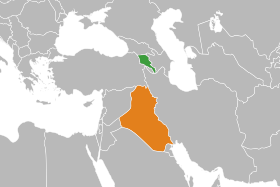Armenians in Iraq

|
|
| Total population | |
|---|---|
| 10,000–20,000 | |
| Regions with significant populations | |
| Cities- Baghdad, Mosul, Basra, Kirkuk, Dohuk, villages- Avzrog Havresk, Ishkender | |
| Languages | |
| Armenian, Arabic, Kurdish | |
| Religion | |
| Christianity (mostly Armenian Apostolic, some Armenian Catholics) |
The history of Armenians in Iraq is documented since late Babylonian times. The Tigris and Euphrates rivers both have their sources in the Armenian Highland, hence, the land of Iraq and the land of Armenia have always been connected. Today it is estimated that there are around 10,000-15,000 Armenians living in Iraq, with communities in Baghdad, Mosul, Basrah, Kirkuk and Dohuk, Zakho, and Avzrog. They make up the second largest solely Christian ethnicity in the country, after the indigenous Assyrians.الفقرة إدراج الأرمن العراقيين 
أرمينيا العراق مجموع السكان 10،000-20،000 المناطق مع الهامة السكان Cities- بغداد، الموصل، البصرة، كركوك، دهوك، villages- أفزروك Havresk هو Ishkend اللغات الأرمينية، العربية والكردية دين المسيحية (ومعظمهم الرسولية الأرمنية، وبعض الأرمن الكاثوليك)  تم توثيق تاريخ Armenians في Iraq منذ زمن Babylonian في وقت متأخر. وTigris وEuphrates النهرين لها مصادرها في Armeni هي Highland، [1] وبالتالي، فإن أرض Iraq وأرض Armenia لها دائما تم توصيله. اليوم تشير التقديرات إلى أن هناك حوالي 10،000-15،000 أرمني يعيشون في العراق، مع المجتمعات المحلية في Baghdad، Mosul، Basrah، Kirkuk [2] وDohuk ، Zakho، وAvzrog. [3] وهم يشكلون ثاني أكبر العرق Christian فقط في البلاد، بعد Assyrians السكان الأصليين.
...
Wikipedia
